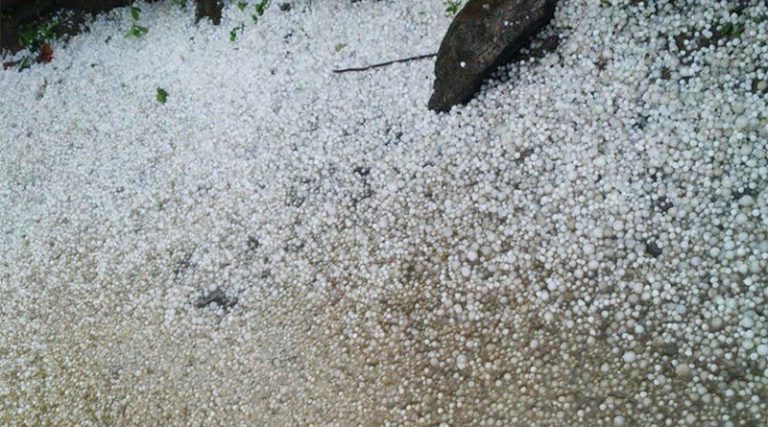Heavy Hailstorms Leave Pools And Gardens In Ruins

Table of Contents
Assessing Hail Damage to Your Pool
Heavy hailstorms can inflict considerable damage on swimming pools, both above and below the waterline. The impact of large hailstones can crack pool surfaces, damage pool liners, and even compromise the structural integrity of the pool itself. Understanding the extent of the damage is the first crucial step in the recovery process.
- Surface Damage: Hailstones can crack tile, plaster, and fiberglass pool surfaces, leading to leaks and costly repairs. Inspect your pool thoroughly for cracks, chips, discoloration, and any signs of water loss indicating potential leaks. Pay close attention to the pool coping, the area surrounding the pool, and the steps for any damage.
- Equipment Damage: Pool pumps, filters, heaters, and other equipment are often vulnerable to hail damage. Check for dents, cracks, or malfunctioning components. Power outages during the storm may also affect the equipment’s functionality. Consider covering your pool equipment during severe weather forecasts in the future.
- Debris Removal: Following a hailstorm, your pool will likely be filled with debris such as leaves, branches, and hail remnants. Promptly remove all debris to prevent clogging your filter and maintain water quality. Use a pool skimmer net and a leaf rake to efficiently remove debris.
- Water Quality: Hailstorms can contaminate pool water with debris and pollutants, affecting the pH balance and clarity. Test your water immediately after the storm using a reliable pool testing kit and take corrective actions such as backwashing the filter and potentially adding chemicals to restore balance. Consult your pool professional for advice on restoring optimal water chemistry.
Repairing Hail-Damaged Pools: A Costly Affair
Repairing hail-damaged pools can be an expensive undertaking. The cost depends significantly on the extent of the damage, the type of pool surface (concrete, fiberglass, vinyl liner), and the necessary repairs. Understanding the cost implications is crucial for budgeting and insurance claims.
- Insurance Claims: Filing an insurance claim is crucial. Thoroughly document all damages with detailed photos and videos before starting any repairs. Note the date and time of the hailstorm and the severity of the damage. Work with a qualified pool contractor who can provide accurate repair estimates for your insurance adjuster.
- Professional Help: Repairing hail damage often requires the expertise of a licensed and insured pool professional. Attempting DIY repairs can exacerbate the problem and void warranties. Seek multiple quotes from reputable contractors to compare prices and services.
- Cost Considerations: Expect a wide range of costs. Minor repairs such as patching small cracks might be relatively inexpensive, while major structural repairs, liner replacements, or complete resurfacing can be extremely costly. Get multiple quotes from reputable contractors before committing to repairs.
Hailstorm Havoc in Gardens: Recovering Your Green Space
Gardens are particularly vulnerable to the destructive force of heavy hail. The impact can damage plants, break branches, and even destroy entire crops, leaving gardeners devastated. Recovery requires patience and attention to detail.
- Plant Damage Assessment: Thoroughly inspect your plants for damage, including broken stems, bruised leaves, hail marks on the fruit, and damaged flowers. Remove any severely damaged parts using clean, sharp pruning shears to prevent disease.
- Immediate Actions: Water your plants thoroughly after a hailstorm to help them recover from the shock. Support damaged branches with stakes or plant supports to prevent further damage. Remove any hail-damaged debris from the garden beds.
- Pest and Disease: Hail damage weakens plants, making them more susceptible to pests and diseases. Monitor your plants closely for signs of infestation and take appropriate actions using organic pest control methods if possible.
- Long-Term Recovery: Some plants may take time to recover. Consider mulching around plants to help retain moisture and provide protection. Regular fertilization might be necessary to stimulate growth, depending on the severity of the damage.
Conclusion: Protecting Your Property After Heavy Hailstorms
Heavy hailstorms can inflict significant damage to pools and gardens, resulting in substantial financial and emotional burdens. Prompt assessment of the damage, proper documentation for insurance claims, and engaging qualified professionals for repairs are crucial steps in the recovery process. Remember to document everything with photos and videos and immediately contact your insurance provider. By taking proactive steps such as reinforcing vulnerable structures and having appropriate insurance coverage, you can mitigate the effects of future heavy hailstorms on your pool and garden. Don't delay—take action to protect your property from the devastating effects of future heavy hailstorms. Start by assessing your damage today and contacting the appropriate professionals.

Featured Posts
-
 Stallones Unmade Sequel A Crime Thriller That Could Have Been Terrible
May 12, 2025
Stallones Unmade Sequel A Crime Thriller That Could Have Been Terrible
May 12, 2025 -
 Key Indy Car Driver To Miss 2025 Indy 500 Race
May 12, 2025
Key Indy Car Driver To Miss 2025 Indy 500 Race
May 12, 2025 -
 John Wick 5 Production Status Release Date And Cast Speculation
May 12, 2025
John Wick 5 Production Status Release Date And Cast Speculation
May 12, 2025 -
 Ksiaze Andrzej I Masazystka Szczegoly Kontrowersyjnego Zabiegu
May 12, 2025
Ksiaze Andrzej I Masazystka Szczegoly Kontrowersyjnego Zabiegu
May 12, 2025 -
 Increased Risk For Indy 500 Drivers In 2025
May 12, 2025
Increased Risk For Indy 500 Drivers In 2025
May 12, 2025
